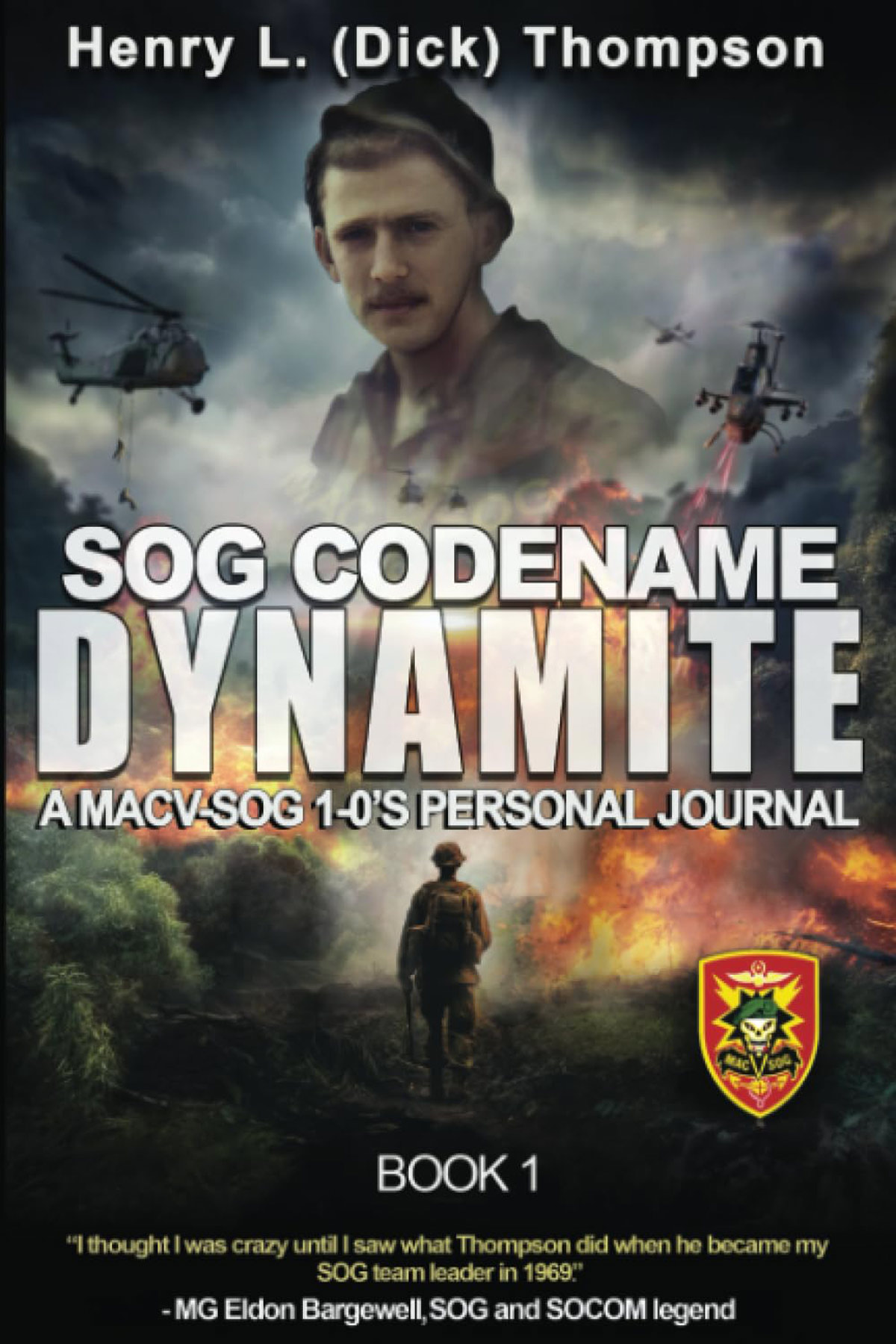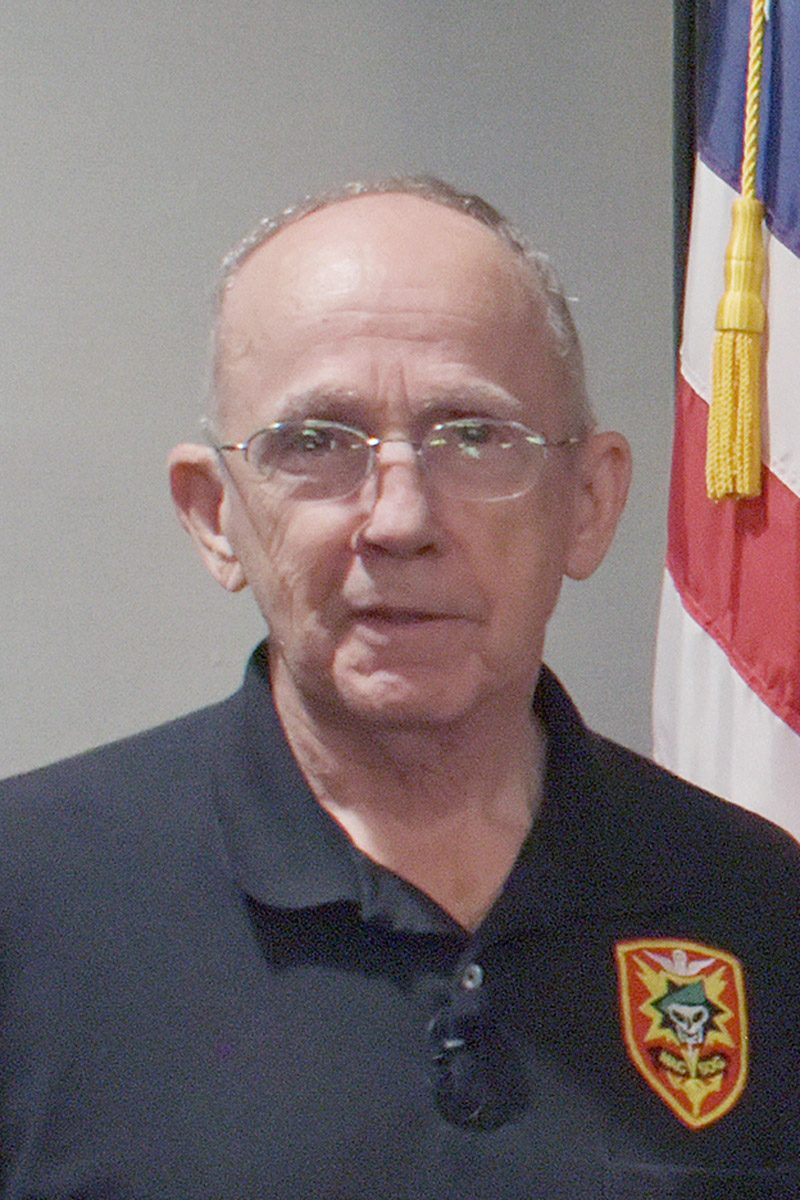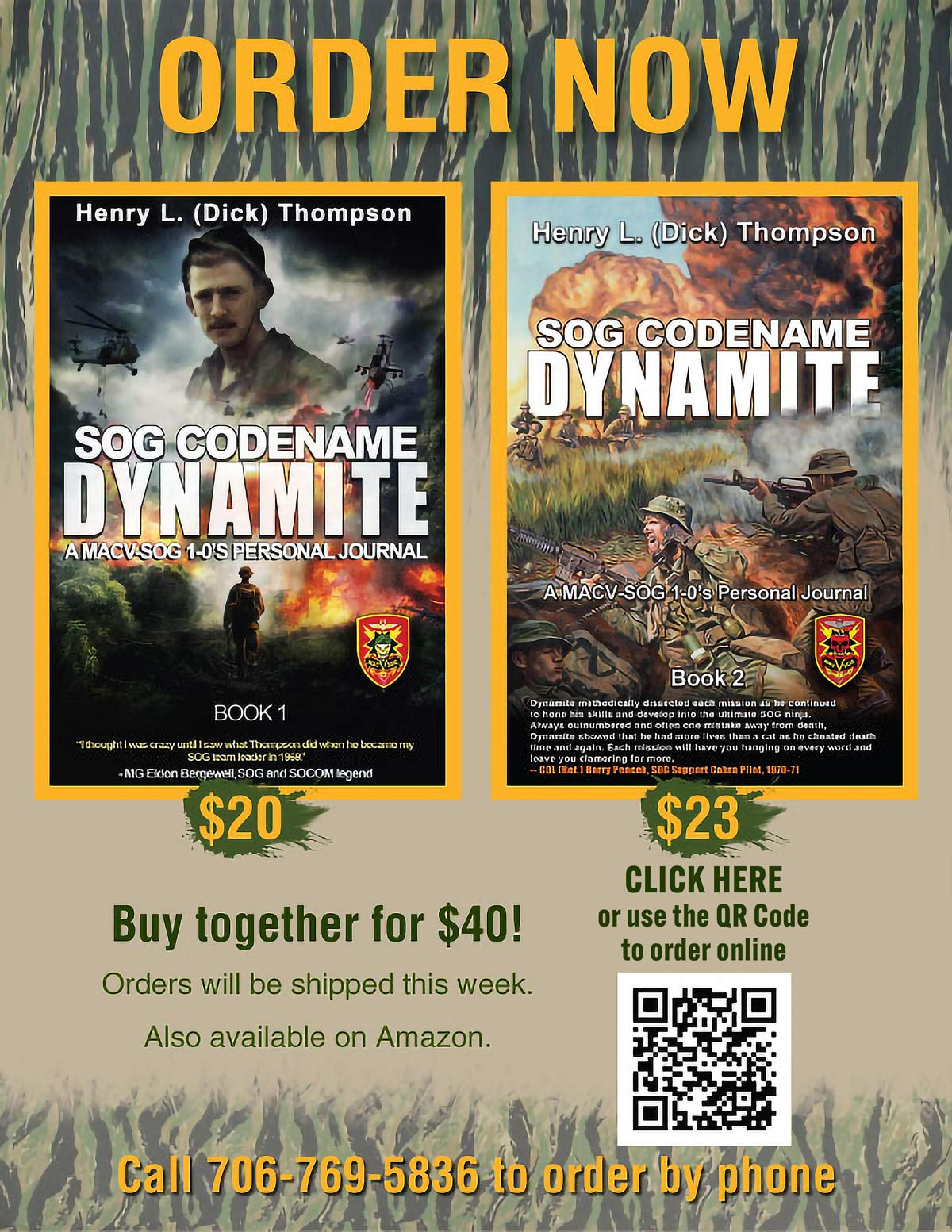AN EXCERPT FROM
SOG CODENAME
DYNAMITE
A MACV-SOG 1-0’S PERSONAL JOURNAL

By Henry L. (Dick) Thompson
Excerpt from SOG Codename Dynamite Book 1, Independently Published, Copyright 2023, pages 101-108
RT Alabama Mission 3: Eldest Son & Gas SOG #3 (18 DEC 68)
Mission 3 Team Roster
Deck: 1-0
Thompson: 1-1
Jones: 1-2
Cowboy: Interpreter
Hoa: Pointman
Du: M-79
Quan: Alternate point
Team Mission
After a day of rest, we were assigned another mission with a short prep time. Our mission was to locate and contaminate an NVA ammunition cache near a major supply route in the eastern part of the Demilitarized Zone (DMZ) between South Vietnam and North Vietnam using Eldest Son—also called exploding ammunition, Italian Green and Pole Bean. Eldest Son was one of SOG’s insidious black PsyOps programs. It was designed to invoke a deep psychological fear in the enemy. The plan called for a quick, clandestine mission to the ammunition cache while conducting a diversionary airstrike on a nearby bridge using F-4s. RT Alabama started preparing immediately for an 18 DEC 1968 insertion. We were getting into the “darker” missions of SOG right away.
Training
This mission would involve not only 7.62mm rounds, but also 12.7mm rounds and 82mm mortar rounds. Proper placement of this ammunition would be difficult and critical. We were scheduled to meet with a CIA operative for some specific Eldest Son training the next day. Unknown to him and us, he would also share information that would leave us, especially me, stunned!
Normally, Eldest Son insertions were accomplished using a special all-American SOG team that followed closely behind B-52 strikes, constructed hastily prepared bunkers/fighting positions, then “salted” them with the faulty ammunition. Unfortunately, two weeks prior, on 30 NOV 1968, an Eldest Son team’s helicopter was hit with 37mm anti-aircraft fire and fell like a rock to the jungle canopy 3,000 feet below, exploded and burned. The air crew and seven SOG team members died that day. A Bright Light mission (mission to recover a missing team or team members) was not attempted because of the location and number of NVA in the area.
I was shocked when he shared this information. I realized that I had inventoried the personal effects of these SOG heroes, including my friend Ray Stacks, on my second day at FOB-1. This small piece of SOG had come full circle. In a week I would be inserted as part of a team to complete their mission. (See the KIAs listed at the beginning of Chapter 4. Their remains would not be repatriated until 20 years later.)
This mission would be a clandestine operation on an ammunition storage area where we would infiltrate the storage area and appear to leave it untouched. In reality, we would leave some deadly, black psychological ops surprises for the future users of this ammunition cache. The last thing I remembered as I was falling asleep that night was the image of Dick Fitts’ two-year-old son, Rich, in my mind.
Travel
We left FOB-1 right after lunch on 18 DEC 68 and arrived at the Quang Tri launch site at 1330. We were scheduled for a 1600 launch. In addition to the standard Mission Package, we would have a flight of four F-4s flying Combat Air Patrol to intercept any NVA MiGs that might try to attack us. The weather was great, not a cloud in the sky, with a 5–10 MPH wind out of the northeast. That was also the orientation (direction) of the ridge on which our LZ was located. It should be a smooth landing.
We were traveling relatively light. We would go in late in the day concurrently with an airstrike on a bridge approximately 3,000 meters northwest of our LZ, designed to focus attention away from our insertion. Once on the ground we would move quickly to the storage area and attempt to recon the site before dark. Once it was dark, we would go in, make our deposits and head back to the LZ for a night pickup (very unusual). The Air Force would pound the bridge area again with F-4s to cover our extraction. Simple plan. In and out.
Final Mission Brief
RT Alabama would be inserted with a UH-1D helicopter with a chase UH-1D, two Cobra gunships escorting the team UH-1D, two more Cobras on station, two A-1s on station, two F-4s flying Combat Air Patrol to keep the North Vietnamese MiGs away, a FAC/Covey directing the airstrike and two F-4s delivering the strike on the bridge. All missions in the DMZ and North Vietnam required F-4 Air Cover to fend off North Vietnamese MiGs.
Insertion
After the Final Mission Briefing, Deck conducted a final team briefing and moved to the aircraft. The takeoff was smooth, and there was no anti-aircraft fire on the way to the target. The reports coming from the AO seemed to be good. I was excited about this mission. Go in. Do it. Get out. I’d done a lot of night extractions in Special Forces and Ranger training, so I wasn’t concerned about this part of the mission.
As we turned on short-final I could see the F-4s pounding the bridge and surrounding area. I didn’t see any activity around our LZ. Our approach was smooth and fast. Deck gave the signal to get on the skids. The plan was for the chopper to do a touch and go. We had to get off the skids fast because it was not going to stop. We jumped off, the chopper lifted off quickly, and then it hit us—CS gas! The NVA were gassing the LZ—and we didn’t bring our masks! My eyes burned and watered, and it was difficult to breathe. That light breeze mentioned in the final mission brief brought a cloud of CS gas down the long axis of the LZ. Then to make it more exciting, the NVA opened fire on us.
I called Covey and told him what was going on and that we needed to be extracted. When he came back to me, he said the air crew did not have masks either. They could not come in to get us until the CS gas had dissipated. Covey turned the Cobras loose on the wood line at the northwest end of the LZ. The CS gas had started to dissipate quickly. It appeared to be a small force of about ten NVA at the LZ. Deck made the decision to go after them. It was like chasing rabbits. It only took about 15 minutes with the help of Covey and the Cobras to terminate them. They did not seem to fight like normal NVA.
Now we had a decision to make. It was going to be dark in about 45 minutes. Our entry had been compromised. Did we continue the mission even though they knew we were there, or did we abort? I recommended that we continue the mission. If we moved fast, we could get to the storage area before dark, see what it looked like and be ready to go in by 2200. By 2400 we could be on our way back to the LZ. If we ran into any problems, we would withdraw and bomb the storage site. We could still leave our packages there. Deck agreed. He told Covey our decision and briefed the team. We moved toward the storage area at a fast pace.
We arrived at the southeast side of the storage area about 15 minutes before dark and transmitted the “onsite” code word. We did not see any security or activity inside the area. It did not have a fence around it. I heard a couple short dog barks indicating they probably had security dogs. Our plan was to take them out with our .22 caliber pistols with integrated silencers if they came after us. I also had CS powder (with black pepper mixed in) with me. If they tried to use the dogs to track us, I could really mess up their nostrils.
Cowboy and I looked around and located the areas where we needed to plant the packages. Deck agreed to let Cowboy and me go into the area as a team and insert the Eldest Sons while he kept the team ready to provide overwatch support if we got into trouble and needed extracting. We had a plan. I encoded the plan and sent it to Covey, who had returned to an orbit near the AO to be available to provide support. Cowboy got what we needed, and we all rested until 2130. I sent the “starting insertion” code word to Covey.
It was pretty quiet at that point. Cowboy and I moved into the storage area and planted the mortar rounds first. They were big and heavy. We were glad to get rid of them. Next were the 12.7mm rounds then the 7.62mm.
I thought I heard something when we were finishing with the 7.62mm plant. I turned to see a dog in the attack position about three feet from me. He launched as I was bringing my .22 pistol up, and I managed to shoot him three times in the chest. He cried out, hit the ground at my feet and grabbed my ankle! I put two more in the side of his head and it was over, but I was sure we had attracted attention. I grabbed the dog’s hind feet and dragged him into the bushes. Cowboy and I moved quickly toward the perimeter, but not directly toward Alabama. We made a right turn at the perimeter and moved quickly toward the team. As we got close, I used the running password, frog hair.
I sent the “insertion complete” code word to Covey that we had completed the plant and were moving toward the LZ. The team moved quickly to the southwest, staying in the valley for 300 meters, then curved around another 300 meters to the east and up the ridge 100 meters to the LZ. Covey told me the extraction team was ten mikes (minutes) out. We arranged the LZ marking team in a T formation, with the top of the T into the mild wind in the grass with flashlights with red filters on them. The extraction chopper approached with all lights off and identified the LZ marking as Tango. I gave Covey a “Roger that” and the chopper came in. The team boarded quickly and we were off. No shots fired! I saw Deck turn his head toward my side, and I quickly gave him a thumbs up and smile. He laughed.
We were debriefed when we got back to the launch site and flew back to FOB-1 the next morning. We got our new mission that afternoon.
Lessons Learned
- CS gas was one of those things that we didn’t plan for. It was such a rarity for the NVA to use it; we just didn’t do it on this mission. Sometimes we would carry CS grenades and CS rounds for the M79 (40 mm grenades). If we carried CS, then we carried the masks too. If you used CS gas, you had better have a mask or you were going to be as bad off as the NVA, because without fail, the winds would change and it was going to come right back on you. Then you’d be in trouble.
- The new RT Alabama SOP—carry M-17 protective masks. I carried the rule to my future teams.
- Always plan for the unexpected.
- Train for night movement. RTs rarely move at night unless they are trying to escape. We need more training.
- We can execute a night raid.
- We can execute a night extraction.
- The dog at the ammunition cache was an adrenaline rush.
- Animals are the enemy too.
- A dog can take several hits from a .22 unless the bullets hit the right place—so can an NVA.
- This was a Demilitarized Zone (DMZ) operational area which meant that the rules were a little different. NVA MiGs were a possibility. The DMZ itself was considered a much more sensitive target politically.
- After this mission I started carrying an Eldest Son AK-47 magazine with me on most missions (unless we were using AK-47s). I was required to keep detailed notes on where and how I deployed it as an Easter egg for the NVA to find—and maintain its security to prevent US and SOG members from accidentally using it.
- The first group of NVA ran from us! We were very aggressive, hunted them down and terminated them. They were guards. They were not the normal NVA warriors we fought.
Post-Mission Training
- Continue fitness training. For the most part, the team did not like it or want to do it. I began to camouflage it into mission pre-training by having the team carry their loadout weight for most of our training. I found them to be very strong for their size. They had been carrying a similar weight for a long time.
- We continued working on all IADs and standard operating procedures.
- The team members were not happy about the eating and hydration procedures but did it anyway.
- We did IAD practice on the range, expanded medical training, and focused more on hydration and dealing with dogs.
- We began to spend more time on situational awareness and natural night vision training.
- We spent time talking about and training to be more aggressive.
ORDER NOW!
SOG Codename Dynamite
Book 1 and 2
About the Author:
Henry L. (Dick) Thompson, Ph.D., is President and CEO of High Performing Systems, Inc. — Providing Leadership Solutions for the 21st Century. He is a senior executive, and psychologist, with over 50 years of leadership experience from the battlefield to the boardroom. An internationally recognized consultant, scientist, educator and speaker who helps leaders and organizations move into the High Performance Zone.
LTC (Ret.) Henry (Dick) Thompson, Ph.D., enlisted into the Army in 1967 and was commissioned as a Second Lieutenant in the US Army Infantry in January 1968. After commissioning, Dick’s first assignment was as an Instructor, US Army Special Warfare School, 3rd Special Forces Group, Fort Bragg, NC, in February of 1968. In September of 1968 he was selected to be a team leader with MACV- SOG, 5th Special Forces Group, in the Republic of Vietnam. In January 1970, after finishing his combat tour (which included 20 recon missions with RTs Alabama, Michigan and Virginia), he was assigned as an instructor in the US Army Infantry School Ranger Department and stationed at Camp Frank D. Merrill, Dahlonega, GA. Dick served in several command (2nd Infantry Div, XVIII Abn Corps) and instructional and research (CGSC) roles until being assigned as the Professor of Military Science at the University of Georgia Army ROTC department in June 1986. He retired from the US Army in January of 1988 after 21 years of military service.
Learn more about Dick Thompson at www.hpsys.com


Leave A Comment